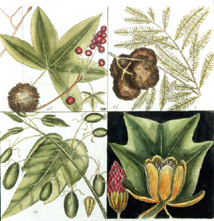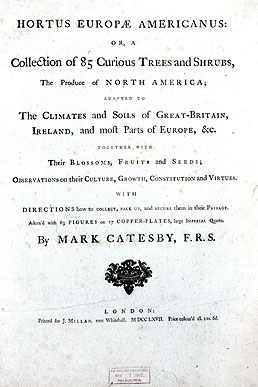 |
| Leaves of Liquidambar and other trees |
Nineteen years after his death in 1767, Mark Catesby's New World experiences were tapped one more time in the service of a lavishly illustrated work of American natural history. Published in large quarto with 63 figures on 17 hand-colored copper plate engravings, the
Hortus Britanno-Americanus was devoted to American botany, including 85 hand-colored plates drawn and engraved by Catesby.
Catesby's focus on utility, broadly speaking, is reflected throughout the Hortus. The sassafras, he noted, "is very well known as a sweetener of the blood" and is used in Virginia to treat remittent fevers, while Liquidambar, the sweetgum, produced "good timber" for wainscotting and joinery, while its "fragrant gum" was prized by the Indians as "preservative of the teeth." Of Smilax, the genus of sarsparilla, Catesby recorded that "the inhabitants of Carolina make a diet-drink, attributing great virtues to it in cleansing the blood," while he was of the opinion that Anona, the custard apple or sweetsop, partook of a rank, fetid odor, "nor is the fruit relished but by very few, except negroes."
 |
| Title page of Catesby's Hortus Britanno-Americanus |
Speaking from experience as a supplier to English gardens, Catesby valued the ornamental appeal of American plants. Bowled over by
Magnolia altissima, the "Laurel-tree of Carolina," Catesby waxed over the "magnificent ever-green," stating that its fragrant white blossoms and purple cones gave it "pre-eminence amongst the varieties in the forests of America." Yet despite his utilitarian emphasis, mere inutility never dissuaded Catesby from including plants that fulfilled no clear or immediate need. "By the concurrent endeavours of the philosopher and artisan," he explained, "I question not but many of them will be found useful to purposes, of which at present we have not the least conception." He provided detailed information not only on growth and habit, but on gathering seeds and preparing them for trans-Atlantic shipment and information on how to care for the tender young trees during the harsh English winters.
Catesby's descriptions also include precious insights into the details of daily life in the southern colonies. In discussing the candleberry myrtle, for instance, he notes that in November and December, when the berries are at their peak "it is customary for a man to remove with his family, from his own home, to some island or sand-bank near the sea where these trees most abound, taking with him kettles to boil the berries in; he builds a hut with palmeto leaves, for the shelter of himself and family while they stay, which is commonly three or four weeks."
 |
Magnolia altissima
(click to read Catesby's description) |
The hand-colored
Hortus Europae Americanus originally sold for the princely sum of £1/11/6. Bearing the armorial bookplate of Edward W. Watkin, the APS copy was rebound in the 19th century by Mansell prior to its acquisition in 1905.



